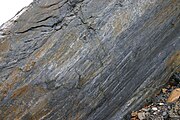Slickenside

In geology, a slickenside is a smoothly polished surface caused by frictional movement between rocks along a fault. This surface is typically striated with linear features, called slickenlines, in the direction of movement.[1]
Geometry of slickensides
A slickenside can occur as a single surface at a fault between two hard surfaces. Alternatively, the
Slickensides have conspicuous shapes that can be used to determine the direction of movement along the fault.[5] Straight slickenlines indicate linear-translational fault motion. They are parallel to the direction of fault motion and serve as a kinematic indicator.[6] Curved slickenlines have recently been studied for their potential to preserve the direction of earthquake rupture propagation.[7]
Surface Roughness
Slickenside formation results in unique roughness on a slip surface. Fault surface roughness (or topography) is characterized by the aspect ratio of asperity height to scale of observation, and this roughness is a key parameter in the study of fault slip.[8] In general, a fault surface appears rougher at smaller scales (i.e. rough and bumpy at approximately millimetre scales and smaller, and increasingly smooth with larger fields of view).[9] This smoothing with larger observation scales is more pronounced in the slip-parallel direction than the slip-perpendicular direction and is commonly a result of slickenside formation.
Mechanisms to create slickensides

The unique geometry of a slickenside can be created in a variety of ways,[10] but the precise mechanisms that create them is not well understood. The grinding between two rocks produces granular material, and there is a change in the behaviour of wear material when the particle size is reduced to nanometers.[11] When the particle size is reduced so dramatically that the surface becomes shiny, it can be characterized as a fault mirror.[11]
A fault mirror may also be the result of fluid being present at the fault surface during slip.[12] Once slip has stopped, this fluid solidifies as a silica gel, which appears shiny and hosts slickenlines.
Asperity plowing
An
Debris streaking
When an asperity plows into the opposing rock, it wears itself and the opposing rock down and produces fine debris. This debris, or wear product, accumulates both in front of and behind the asperity in a long, elongated shape. If the asperity is relatively hard, the debris will accumulate in front of the asperity. If the asperity is relatively soft, the debris will trail behind. This debris hardens over time and is preserved as a form of slickenline.[10]
Erosional sheltering
Some rocks may contain particles that are harder than the rest of the rock. When these rocks are worn, the harder particles will resist wear more than the softer rock, the rock on the

Fibre growth
The fault plane may be coated by mineral fibres that grew in during the fault movement, known as slickenfibres. Due to irregularities in the fault plane, exposed slickenfibres typically have a stepped appearance that can be used to determine the sense of movement across the fault.

Slickenfibres are secondary minerals that make up the slickensides rather than the rock itself. Slickenfibres form in areas where the rock slowly creep past one another rather than sliding suddenly as a result of an earthquake.[14] Unlike slickenlines, which give two possibilities for slip direction, slickenfibres preserve the true slip direction.[14]
Implications
Slickensides provide useful insight into earthquake processes. Calcite slickenfibres have recently been used to constrain the depth of aseismic creep in the Zagros Mountains as well as the orientation of stress acting on the fault.[15] It has also been suggested that when multiple slickenfibre or slickensteps orientations are present, it can indicate that the ongoing shear is not strain softening so slip does not have a constant direction. [11]
In addition to the direction of slip, slickenlines have also been used to constrain the timing of fault slip.[16] They also preserve any complexity in the geometry of the earthquake rupture.[17]
Other types of slickensides
Slickensides in soils
In
Slickensides on the Moon
On the
Gallery
-
Dextral slickenside of pyrite
-
Slickensides on a fault plane, south wall of Bear Valley Strip Mine. Lens cap 5.8cm wide.
-
Slickensides on a fault plane in Corona Heights Park, San Francisco
-
Greenschist with slickensides in Itogon, Benguet, Philippines.
Notes
- .
- ISBN 978-1-107-16348-5.
- .
- ^ .
- .
- .
- doi:10.1130/G46563.1.
- doi:10.1130/G37206.1.
- .
- ^ .
- ^ hdl:1874/351354.
- doi:10.1130/G34483.1.
- .
- ^ .
- .
- .
- .
- ISBN 978-0-643-05813-2.[page needed]
- ^ https://www.lpi.usra.edu/resources/apollo/catalog/70mm/magazine/?82 Apollo Image Atlas (Lunar and Planetary Institute), 70 mm Hasselblad Image Catalog, Apollo 15 photographs AS15-82-11101, AS15-82-11102, AS15-82-11103 and AS15-82-11104
- ^ https://www.hq.nasa.gov/alsj/a15/a15.sta9.html Apollo 15 Lunar Surface Journal – Instant Rock at Station 9
- ^ https://history.nasa.gov/alsj/a15/A15SampleCat_1.pdf Catalog of Apollo 15 Rocks – Part 1. 15015-15299
References
- Allaby, Michael, ed. (2008). "Slickenside". A Dictionary of Earth Sciences. Oxford University Press. ISBN 978-0-19-921194-4.
- McDonald, Ronald C. (1998). Australian Soil and Land Survey: Field Handbook. CSIRO. ISBN 978-0-643-06356-3.
- Passchier, Cees W.; Trouw, Rudolph A. J. (2005). Microtectonics. Springer Science & Business Media. ISBN 978-3-540-64003-5.
External links
- . Encyclopedia Americana. 1920.






